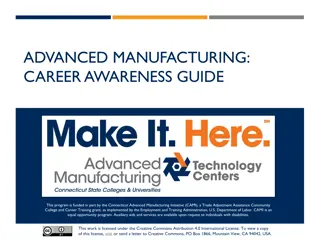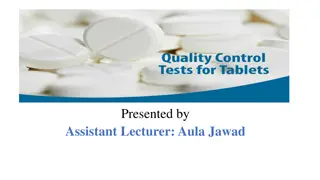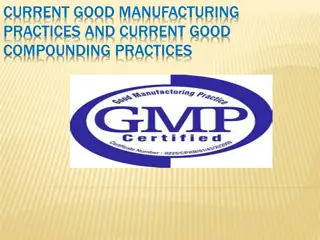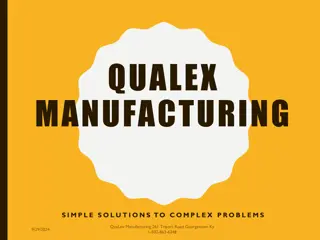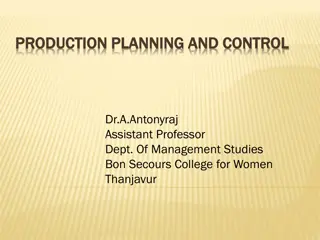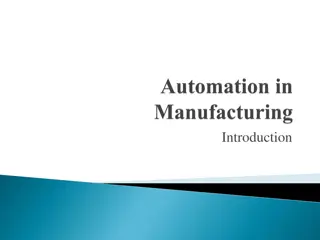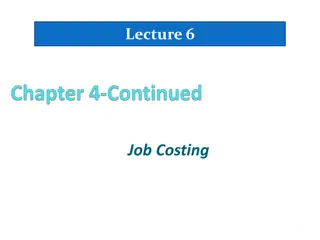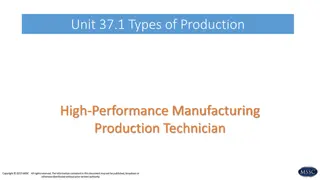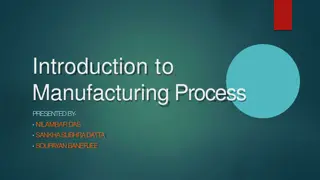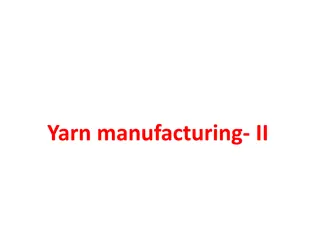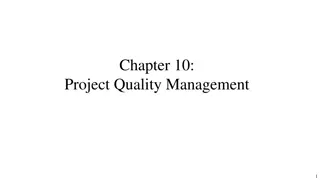Quality Control in Manufacturing Operations
Quality Control (QC) is an essential aspect of manufacturing operations to ensure products meet required quality standards. It involves inspection, analysis, and action to maintain consistent quality levels. Key elements include defining QC, process control, roles of QC personnel, common misperceptions, and the importance of training and equipping QC staff. Effective QC personnel are trained in various subjects and critical in managing materials, sample testing, and understanding mix adjustments. Continuous QC efforts are vital for consistent product quality.
Uploaded on Sep 11, 2024 | 0 Views
Download Presentation

Please find below an Image/Link to download the presentation.
The content on the website is provided AS IS for your information and personal use only. It may not be sold, licensed, or shared on other websites without obtaining consent from the author. Download presentation by click this link. If you encounter any issues during the download, it is possible that the publisher has removed the file from their server.
E N D
Presentation Transcript
56th Illinois Bituminous Paving Conference Clarifying Quality Control Bill Pine, Heritage Construction & Materials
Defining Quality Control Inspection, analysis, and action applied to a portion of the product in a manufacturing operation to estimate overall quality of the product and determine what, if any, changes must be made to achieve or maintain the required level of quality. McGraw-Hill Dictionary of Science and Engineering
Defining Process Control Activities involved in ensuring a process is predictable, stable, and consistently operating at the target level of performance with only normal variation. BusinessDictionary.com
How Do You Define QC? It s not just sample testing by QC personnel! Everyone plays a role Quality Control Production Placement Inspection Individual materials Mixture Processes Equipment Analysis What s wrong? What needs fixed? Action Proactive vs. Reactive
QC Misperception It s not just mixture testing! Mix results maypredict pay, but For unacceptableresults, what s the next step? Constantly testing mix samples, challenges us in performing actual Quality Control Today, we are asking more of our QC personnel than ever before Trained, staffed and equipped?
QC Personnel Must be: Trained Equipped Over time they gain: Knowledge Experience If managed correctly, they ll become invaluable!
QC Personnel Must be trained in numerous subjects: Materials properties Materials testing: Operation, calibration and maintenance of equipment Specification requirements Etc. Must work closely with: Production & Placement personnel Requires knowledge of those operations
QC Personnel Sample (Stockpiles & Mix): Obtain, handle and test Do it accurately and consistently Do it at the right frequency Manage materials Understand the mix: Mix adjustments Impact on production and placement? Snapshot of QCeffectiveness Recognizing segregated samples
Production QC Plant Scheduling: Number of mixes & switchovers Mix verification prior to project start Clearly Identify: Stockpiles (virgin and recycle) AC storage tanks Stockpile Management: Build them right Prevent intermingling Load out of them right Use as many cold feeds as possible Identify Cold Feeds
Production QC Plant Calibration Do it accurately and often Cold feeds AC/Binder Additives Multiple Rates: Low, Medium and High Scales used to measure any of the above
Production QC Plant Operation Production rate Temperature consistency Use and level of silos or surge bins Mix segregation: Are there locations where it is occurring? How can they be fixed? Impacts truck and plate samples! Maintenance: Regularly scheduled items If it s broke, fix it!
Production QC It s not just mix testing! Inspection, Analysis and Action: Action occurs before sampling or before testing We react too often we must be proactive Don t assumethe owner s minimal requirements will suffice QC personnel seldom have time to test and oversee the process QC Managers play a vital role
Placement QC Misperception It s not just density and smoothness testing! Test results maypredict pay, but For unacceptableresults, what s the next step? Many Field QC techs are overwhelmed! Lots of locations to test Often utilized for NON-QC tasks Sometimes undertrained Someone has to look at the BIGpicture
Placement QC Truck Dump Personnel Backing Up and Unloading Trucks: Safely, Timely and Efficiently Communicate with truck driver, MTD and/or paver operator Impacts paver operation, mat consistency & flow of paving train Screed Personnel: Address mat imperfections Strive for consistent texture and uniform density Lute and Shoveling Personnel: Do they improve imperfections? Involvement in plate sampling?
Placement QC Paver Operation Good working order? Slope and grade? Speed: Consistent? Match production rate? Delivery rate? Keep rollers in sight! Screed: Uniform mat? Extensions set properly? Turning 90% of time? Mix at mid-depth? Tunnel and auger extensions?
Placement QC Compaction Rolling Pattern: Number of passes? Pattern layout? Speed? Pattern length? Compaction temperature range for roller position? Directly impacts density and smoothness Rollers = Placement rate? Is each one operating properly? Operator familiar with equipment? Amplitude & frequency settings Water in drums Water spray system Tire pressure
Placement QC There are many other items to pay attention to, such as: Base conditions temp, smoothness, stiffness, texture Ambient conditions air temp, sunlight, wind Prime / Tack type, amount, uniformity of application, adequate cure time Mat thickness available compaction time Is anyone making time to watch these QC items?
Placement QC Sampling/Testing Mix samples: Take them correctly and consistently Identify them clearly and get them sent in Density Gauge: Is it working, and being used properly and frequently? Has it been calibrated to this mix, on this job? Density Cores: Use the right equipment, remove them carefully! Identify clearly and get them sent in Smoothness: Mat thickness, mat temperature, etc.
Paver Screed Obtain density readings every 1 across uncompacted mat and test behind rollers to identify density variability across mat before and after compaction
Paving Direction Obtain density readings every 25 through roller pattern overlap to identify density variability 25 25 X Feet Approximate center of rolling pattern overlap 25 25
In The Past Quality Control Plant Road
Functioning as a TEAM! Quality Control Production Placement Clarify QC and Everyone s Role Train them, Enable them, and Support them
Thank You! Bill Pine QC Director of Asphalt Technology Heritage Construction & Materials billp@thgrp.com (217) 840-4173



